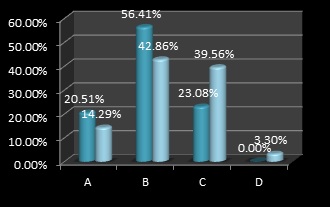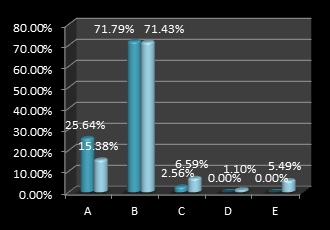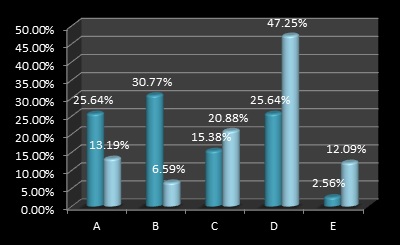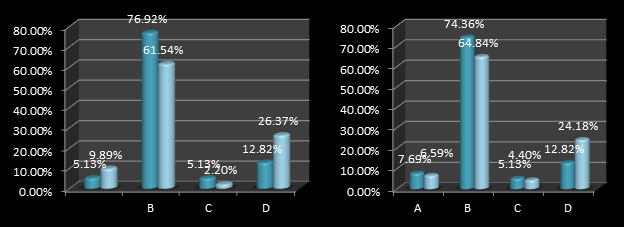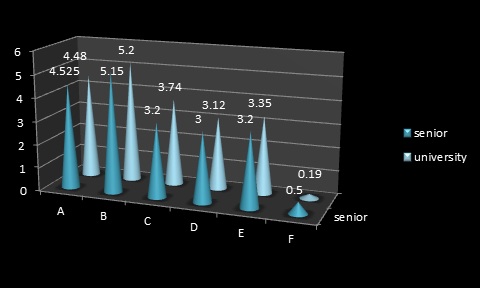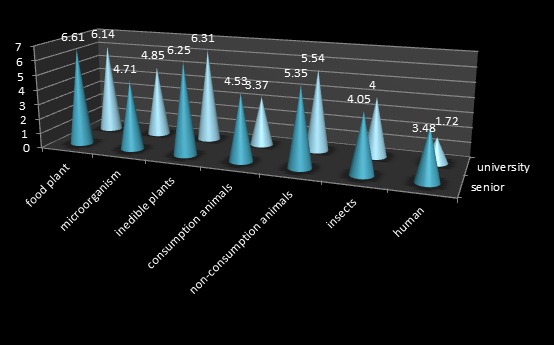Team:Peking S/project/hp/investigation
From 2011.igem.org
(→Public Investigation) |
|||
| Line 18: | Line 18: | ||
<br><br> | <br><br> | ||
| - | Public acceptance of genetically engineered products is influenced by many | + | Public acceptance of genetically engineered products is influenced by many factors. Researchers and biotechnology companies always want to know how well the public accept the products of synthetic biology and whether their products can be put into application. We think that students today are potential consumers in the future. Moreover, the survey result may also tell us what needs to be done. Thus, we visited High school attached to Capital Normal University and Peking University this summer, sent out hundreds of questionnaires, which were designed based on the general issues about synthetic biology and genetically modified organisms (GMOs) the public concern about. By analyzing the outcome of this investigation, we got a rough idea about how students thought about genetically engineered products and it provided a new perspective to look at the products of synthetic biology too. |
| - | The first question aimed at gathering basic | + | The first question aimed at gathering basic information of students. There were 225 students participating in our survey, of which 86 were high school students,139 were university students. We received 39 and 91 copies respectively, with response rates of 45% and 65%. |
| + | |||
| + | Questions of part two investigated the general cognition towards the genetically engineered products of the students. This part of questions investigated how well the students knew about the genetically engineered organisim. The dark blue bar stood for the result of high school students and the light bar was for university students. | ||
| - | |||
| Line 28: | Line 29: | ||
{{Template:Http://2011.igem.org/Team:Peking S/imageboxlarge|image=pkushp1.jpg|caption=Question 1}} | {{Template:Http://2011.igem.org/Team:Peking S/imageboxlarge|image=pkushp1.jpg|caption=Question 1}} | ||
| - | '''Do you know what | + | '''Do you know what genetically engineered organism is? |
| - | A. | + | A.understand very well B.know a little C.have only heard about it D.no idea''' |
| - | + | Most of the high school and university have had lessons concerned with biology. As the technology of genetically engineering applied more and more in our daily life, it is necessary to strengthen information dissemination and education efforts. | |
'''2-2''' | '''2-2''' | ||
{{Template:Http://2011.igem.org/Team:Peking S/imageboxlarge|image=pkushp2.jpg|caption=Question 2}} | {{Template:Http://2011.igem.org/Team:Peking S/imageboxlarge|image=pkushp2.jpg|caption=Question 2}} | ||
| - | ''' | + | '''Do you accept the production of genetically engineered organism?''' |
| - | A. | + | A.Yes B.it depends C.No D.can’t accept it at all |
| - | + | ||
| - | B.it depends | + | |
| - | + | ||
| - | C. | + | |
| - | + | ||
| - | D.can’t accept it at all | + | |
| Line 69: | Line 64: | ||
E. Don’t know | E. Don’t know | ||
| - | |||
| - | The third part of questions | + | Most of students gave ambiguous answers to this question. On one hand, they did not totally understand the principle of producing genetically engineered organism. On the other hand, they were curious about the work and hoped there would be advantages to their life. Thus, they intended to be cautious about this topic. |
| + | |||
| + | The third part of questions looked into students’ acceptance toward application of genetically engineered organism and what they were concerned about. | ||
| Line 80: | Line 76: | ||
'''Would you accept the products of genetically engineering?''' | '''Would you accept the products of genetically engineering?''' | ||
| - | A. No problem B.depends C.No D.absolutely not E. don’t know | + | A.No problem B.depends C.No D.absolutely not E. don’t know |
| - | + | Considering the cautious attitude towards the genetically engineered organism, the result was not beyond the expectations. It told us there was a long road to go to realize technology in practice, because of not only the aspect of slow scientific research but also the aspects of public concern. | |
| Line 92: | Line 88: | ||
'''Do you consider genetically engineered products safe?''' | '''Do you consider genetically engineered products safe?''' | ||
| - | A. All of them are | + | A. All of them are dangerous B. some of them are safe C. all of them are safe D.not sure |
'''3-3''' | '''3-3''' | ||
| - | ''' If you know that most products on market are involved in genetically engineering technology to some extent, | + | ''' If you know that most products on market are involved in genetically engineering technology to some extent, how would you answer the last question?''' |
| - | A. All of them are not | + | A. All of them are not dangerous B.some of them are safe C.all of them are safe D.not sure |
| - | + | Comparing the result of two questions, we found that the difference was not significant between market species and non-market ones, which implies that the regulatory of market was not believed at all. Although the ratio of the people choosing A or D changed a little, most of students did not change their minds, indicating that the regulatory role of market was not a major factor. | |
[[File:question3.jpg|question3]] | [[File:question3.jpg|question3]] | ||
| Line 110: | Line 106: | ||
'''3-4''' | '''3-4''' | ||
{{Template:Http://2011.igem.org/Team:Peking S/imageboxlarge|image=pkushp34.jpg|caption=Question 4}} | {{Template:Http://2011.igem.org/Team:Peking S/imageboxlarge|image=pkushp34.jpg|caption=Question 4}} | ||
| - | '''The reason you choose genetically engineered products | + | ''' The reason that you choose genetically engineered products is? [From the option with most signifinance to the one with least]''' |
| - | a. | + | a. They’re better than the non-transgenic food [in nutrition aspect,for example] |
| - | b. | + | b. Safety [i.e. not harmful to human] |
| - | c. | + | c. Environmental friendly |
| - | d. | + | d. They’re under more effective surveillance by the government |
| - | e. | + | e. Information about the products is easier to access[for example the ingredients] |
| - | f. | + | f. Other reasons__________ |
| + | |||
| + | |||
| + | simple formula to calculate the average score of each option. The option with a higher score ranks relatively higher than the ones with low score. | ||
| + | The formula is | ||
| + | (Σ frequency*weight)/total | ||
| + | The weight for the choice ranking first is 6; the second is 5, and so on. The choices of both senior and university group have the same pattern. Apparently, majority of people,as we mentioned before, concern most about safety. | ||
| - | |||
| - | |||
| - | |||
'''3-5''' | '''3-5''' | ||
| - | '''What do you feel about the subjects below if they are genetically engineered?[please rank all options from 1 point to 10 according to your acceptance to this subject:1 for unbearable,and 10 for totally alright]''' | + | '''What do you feel about the subjects below if they are genetically engineered? [please rank all options from 1 point to 10 according to your acceptance to this subject:1 for unbearable,and 10 for totally alright]''' |
| + | |||
| + | a. Food plant [like rice]__ | ||
| - | + | b. Microorganism [like bacteria]___ | |
| - | + | c .Inedible plants__ | |
| - | + | d. Consumption animals [like chicken]___ | |
| - | + | e. Non-consumption animals | |
| - | + | f. Insects___ | |
| - | + | g. Human___ | |
| - | |||
Revision as of 08:42, 5 October 2011
Template:Https://2011.igem.org/Team:Peking S/bannerhidden Template:Https://2011.igem.org/Team:Peking S/back2
Template:Https://2011.igem.org/Team:Peking S/bannerhidden

Human Practice
Introduction|Synthetic Biology vs. Genetically Modified Organism|Public Investigation|Risks and Measurements Analysis
|Acknowledgement&Reference
Public Investigation
Public acceptance of genetically engineered products is influenced by many factors. Researchers and biotechnology companies always want to know how well the public accept the products of synthetic biology and whether their products can be put into application. We think that students today are potential consumers in the future. Moreover, the survey result may also tell us what needs to be done. Thus, we visited High school attached to Capital Normal University and Peking University this summer, sent out hundreds of questionnaires, which were designed based on the general issues about synthetic biology and genetically modified organisms (GMOs) the public concern about. By analyzing the outcome of this investigation, we got a rough idea about how students thought about genetically engineered products and it provided a new perspective to look at the products of synthetic biology too.
The first question aimed at gathering basic information of students. There were 225 students participating in our survey, of which 86 were high school students,139 were university students. We received 39 and 91 copies respectively, with response rates of 45% and 65%.
Questions of part two investigated the general cognition towards the genetically engineered products of the students. This part of questions investigated how well the students knew about the genetically engineered organisim. The dark blue bar stood for the result of high school students and the light bar was for university students.
2-1.
Do you know what genetically engineered organism is?
A.understand very well B.know a little C.have only heard about it D.no idea
Most of the high school and university have had lessons concerned with biology. As the technology of genetically engineering applied more and more in our daily life, it is necessary to strengthen information dissemination and education efforts.
2-2
Do you accept the production of genetically engineered organism?
A.Yes B.it depends C.No D.can’t accept it at all
2-3
How do you evaluate the relative merits of genetically engineered organism?
A. The pros outweigh the cons. B. The gains balance the losses. C. The cons outweigh the pros. D. Depends E. Don’t know
Most of students gave ambiguous answers to this question. On one hand, they did not totally understand the principle of producing genetically engineered organism. On the other hand, they were curious about the work and hoped there would be advantages to their life. Thus, they intended to be cautious about this topic.
The third part of questions looked into students’ acceptance toward application of genetically engineered organism and what they were concerned about.
3-1
Would you accept the products of genetically engineering?
A.No problem B.depends C.No D.absolutely not E. don’t know
Considering the cautious attitude towards the genetically engineered organism, the result was not beyond the expectations. It told us there was a long road to go to realize technology in practice, because of not only the aspect of slow scientific research but also the aspects of public concern.
3-2
Do you consider genetically engineered products safe?
A. All of them are dangerous B. some of them are safe C. all of them are safe D.not sure
3-3
If you know that most products on market are involved in genetically engineering technology to some extent, how would you answer the last question?
A. All of them are not dangerous B.some of them are safe C.all of them are safe D.not sure
Comparing the result of two questions, we found that the difference was not significant between market species and non-market ones, which implies that the regulatory of market was not believed at all. Although the ratio of the people choosing A or D changed a little, most of students did not change their minds, indicating that the regulatory role of market was not a major factor.
3-4
The reason that you choose genetically engineered products is? [From the option with most signifinance to the one with least]
a. They’re better than the non-transgenic food [in nutrition aspect,for example]
b. Safety [i.e. not harmful to human]
c. Environmental friendly
d. They’re under more effective surveillance by the government
e. Information about the products is easier to access[for example the ingredients]
f. Other reasons__________
simple formula to calculate the average score of each option. The option with a higher score ranks relatively higher than the ones with low score.
The formula is
(Σ frequency*weight)/total
The weight for the choice ranking first is 6; the second is 5, and so on. The choices of both senior and university group have the same pattern. Apparently, majority of people,as we mentioned before, concern most about safety.
3-5
What do you feel about the subjects below if they are genetically engineered? [please rank all options from 1 point to 10 according to your acceptance to this subject:1 for unbearable,and 10 for totally alright]
a. Food plant [like rice]__
b. Microorganism [like bacteria]___
c .Inedible plants__
d. Consumption animals [like chicken]___
e. Non-consumption animals
f. Insects___
g. Human___
 "
"
